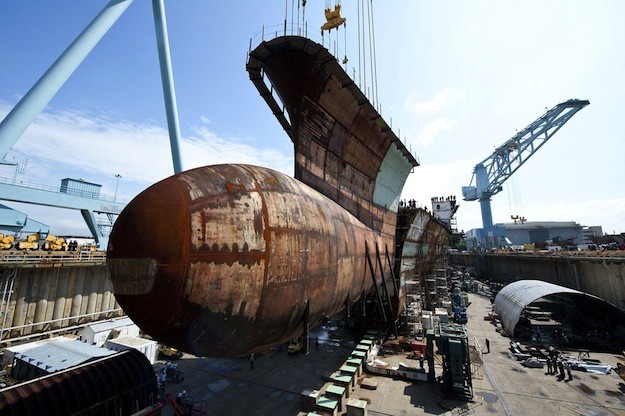Gerald R Ford aircraft carrier lower bow lift. Photo by Ricky Thompson via Huntington Ingalls
(Bloomberg) — Mitt Romney’s pledge to build 15 Navy vessels a year, up from about nine a year now planned, is a goal that will probably be reached in his first term, a campaign adviser said today.
The Navy’s plans now call for seven vessels in 2014, eight in 2015, nine in 2016 and seven in 2017. That’s 31 vessels for a planned expenditure of $53.3 billion. The plan also anticipates 11 vessels in 2018 and nine in 2019. Over 30 years, the Navy’s ship purchases will average about 8.9 vessels a year, according to the Congressional Budget Office.
Romney, the Republican presidential nominee, said this week during a foreign policy speech at Virginia Military Institute that he’d “restore our Navy to the size needed to fulfill our missions by building 15 ships per year.” He didn’t set out a time frame.
In a Romney presidency, “you’ll be on the path” to 15 vessels per year by fiscal 2014 and “probably hit it, you know, by ’15 or ’16,” Romney adviser Dov Zakheim said at a breakfast meeting with reporters today in Washington.
“You can hit it in the first term, definitely in the first term,” said Zakheim, who was the Pentagon’s comptroller in President George W. Bush’s administration and an adviser in previous Republican presidential campaigns.
Huntington, Raytheon
Companies that would benefit from ship spending increases of this magnitude include vessel and electronic-warfare contractors Huntington Ingalls Industries Inc., General Dynamics Corp., Lockheed Martin Corp. and Raytheon Co. Babcock & Wilcox Co. is the major supplier for Navy nuclear propulsion programs on the Virginia-class submarine that Romney wants to increase to three a year from the planned two.
Romney gave his foreign policy speech in Virginia, a closely contested state in the election, where Huntington Ingalls has its largest shipbuilding operation and the Navy has its largest base.
Zakheim and his son Roger Zakheim, who’s also a Romney adviser, today reiterated Romney campaign themes on defense, including improvements in purchasing and management for shipbuilding.
Funds for more naval spending also would come from Romney’s projection that his policies would bring more economic growth and from reductions in domestic entitlement spending that could sustain defense expenditures at 4 percent of U.S. Gross Domestic Product, they said.
Littoral Combat Ship
Former Navy Secretary John Lehman and former Missouri Senator and Representative James Talent are among the closest Romney advisers who “really interact with him” on defense issues, Dov Zakheim said.
Talent is a former chairman of the Senate Armed Services Committee’s seapower panel, where he pushed for increased naval spending. Lehman is best known for his advocacy in President Ronald Reagan’s administration for a 600-ship fleet.
The added vessels wouldn’t include Littoral Combat Ships in excess of the 55 already planned, Zakheim said. Lockheed Martin is making one version; Austal Ltd. and General Dynamics Corp. make the other version.
Those vessels are intended to patrol coastal water for mine-sweeping, anti-submarine warfare and operations against smaller vessels. They aren’t designed for high-intensity warfare or providing protection for Navy aircraft carriers.
“You’ll still be building the LCS program, you’re not getting rid of” it, Zakheim said. Still, “I wouldn’t call an LCS equivalent to a major escort for a carrier.”
Wisconsin, Alabama
Lockheed Martin, based in Bethesda, Maryland, is leading construction of its ship model in Marinette Marine Corp.’s shipyard in Marinette, Wisconsin, home state to Romney’s running mate Paul Ryan. The version by Austal, based in Henderson, Australia, and General Dynamics, based in Falls Church, Virginia, is being built in Mobile, Alabama.
Romney’s new spending would focus on buying the three Virginia-class submarines annually and larger warships such as destroyers and potentially new cruisers to escort aircraft carrier groups, Zakheim said.
Reviving a cruiser program the Navy terminated “is being discussed,” Zakheim said.
“There are going to be people who want more big-deck cruisers, there are people who will say, ‘No, we want destroyers,’ and he’s going to make up his mind,” Zakheim said of Romney.
Increasing naval spending complements Romney’s approach to diplomacy that calls for backing it with “a strong military presence,” Zakheim said. “The best form to do that is by having a Navy in Asia.”
What candidate Romney is “trying to do is diplomatically convey strength, and the Navy is the best way to do that,” Zakheim said.
-By Tony Capaccio. Copyright 2012 Bloomberg.

 Join The Club
Join The Club











